by Sara Bissen
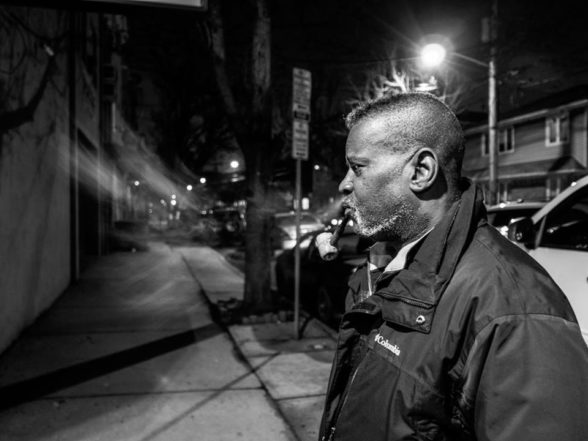
Kevin Blythe Sampson, Newark. (2016). Photograph by Cesar Melgar.
NEWARK WITHHELD
Newark Withheld is a series by Sara Bissen about Newark, New Jersey today, as seen through the eyes of its long-standing artists.
Opened by Kevin Blythe Sampson, Newark Withheld initiates a discussion by local artists in relation to the transformation of their city. This artist series extends from the photographic body of work by Cesar Melgar in Newark, featured in the rural issue of the Journal of Biourbanism.[1]
ARTISTS
Kevin Blythe Sampson—“Newark is in danger because of its realness, power, and history.”
Gladys Barker Grauer—“Newark sensed it.”
Cesar Melgar—“Razing history to make surface lots is a famous Newark administration pastime.”
James Wilson—Newark, “when it’s your hood then you’ve never felt more at home.”
German Pitre—“Newark has always been known for that edginess.”
—a closing with Lauren Sampson
Interview with Kevin Blythe Sampson by Sara Bissen
Between decay and gentrification, artist Kevin Blythe Sampson is fighting an uphill battle for the inclusion of Newark’s indigenous artists within their own city.
Upon my first introduction to Kevin, he tells me—“Newark, although it’s coming back, has no intention of supporting the artists that have been here. I know that there will be lots of new spaces for new people, but I am not sure if it will trickle down to the poor in Newark.” We are talking about the urban and social core of Newark and about its transformation experienced by its native artists, thus embracing their voices over those of urban planners, designers, and strategists. This series sets out to understand a process occurring in Newark, based on the reality that Newark has something very important to say.
NEWARK—an overview
In 1666, Newark was founded along the Passaic River in the Northeastern United States. Newark witnessed both the First Great Migration (1910–1940) when African Americans from the rural South moved to the industrialized North, and the Second Great Migration (1940–1970) that led to further urbanization—despite Newark’s own overall internal population decline in the 1930s and since the 1950s. Newark’s era of urban renewal (1949–1967) was initiated by the Newark Housing Authority (NHA) under the Housing Act of 1949. “Blight,” “clearance,”[2] and “white flight” defined a post-World War II and onwards suburbanizing process. The Newark Rebellion occurred in 1967.[3] Over 50 years, Newark’s population consistently declined until the 2000s when a slight, steady increase began. Newark’s 1950 population was 438,776. As of 2015, Newark’s estimated population was 281,944.[4]
In 2012, nearly half of Newark’s people were “living in true poverty”.[5] Current unemployment is 6.6%.[6] The city has the highest homeless population in the state of New Jersey. Noticeably, Newark attracts homeless people from neighboring regions of the United States because of its tolerance and opportunities for squatting.[7] Today, 2,891 homes in Newark are in some stage of foreclosure.[8]
As a major port and manufacturing city turned financial and servicing city, Newark is 20 minutes by train from New York City’s World Trade Center site. Foreclosure in Newark manifests as vacancy, with many people living on streets next to many empty homes. The present population has a Black majority with recent rises in Latinos.
Newark’s most recent passage through history can be defined by traceable relationships of capital flow, urban renewal/revitalization, urban decay, and forms of resistance.[9] From the viewpoint of land dispossession, Newark has a long and varied history with many phases of decay. We are only witnessing its most recent. This is the effect of the market, but on the other hand, is a response to it. In Newark, decay seems responsive to the system itself, where in the face of urban development, fake façades crumble in front of the authenticity of art produced by those from here. Piecemeal revitalization in Newark takes place today. One has the clear impression that the capital accumulation needed for such revitalization leads to forced displacement and even more decay.
Newark tells the reality of the whole system—of the decay and the cracks.[10] Sampson and the five Newark artists presented here are witnesses to the city’s change with an acute sensitivity. They possess what others seek.
KEVIN BLYTHE SAMPSON
Kevin Blythe Sampson is a retired Police Detective where he worked as a Composite Sketch Artist for a New Jersey Police Department in Scotch Plains. In the presence of found objects, Sampson works with what the dominant system labels useless. He lives a life of magic. His work is a reclamation of soul from the deepest parts. This soul is undivided from politics, yet this soul remains unseen by the dominant system. This is Sampson’s insight, and it comes from the inside.
The deformation and destruction of Newark’s social relations is an objectification that also occurs elsewhere, especially in cities. It is a form of taking people away after real estate and money, and absorbing everything and everyone into an abstract, dead simulacrum of value (we became used to calling it “economy”). Sampson undoes such an objectification through an assemblage that gives back a relation of reality and memory to his found objects. His work unthaws the ice.
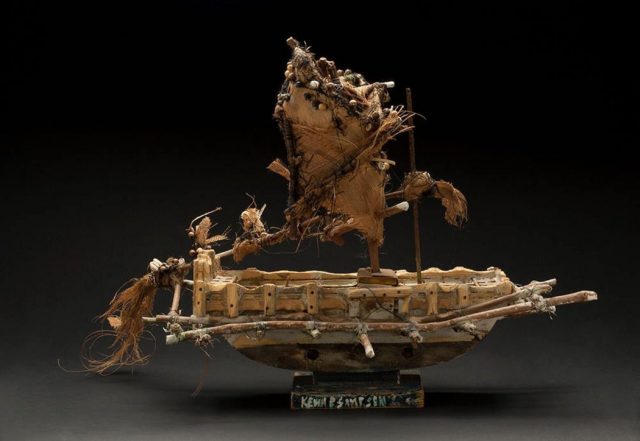
Spawn of the South (2014) by Kevin Blythe Sampson. Mixed media, 16in x 20in x 14in. Image courtesy of the Artist.
The work of Sampson is an unearthing of a spirit world that is actually looking for him. This power, reclamation, and performative act takes the form of ships, cathedrals, and even whole yard shows—the latter of which were a once common social activity in the rural Deep South during the 20th century. Sampson’s process, and his life’s work, is to find objects and bring them back to their value that an overarching power does not even recognize, like discarded pieces of wood, strings, and bones. This agency given to the object is tied to the spiritual power of the American Hoodoo practice that stems from the African diaspora. This mobility conjures magic, rootwork, and healing for the reality of life in the African-American culture.
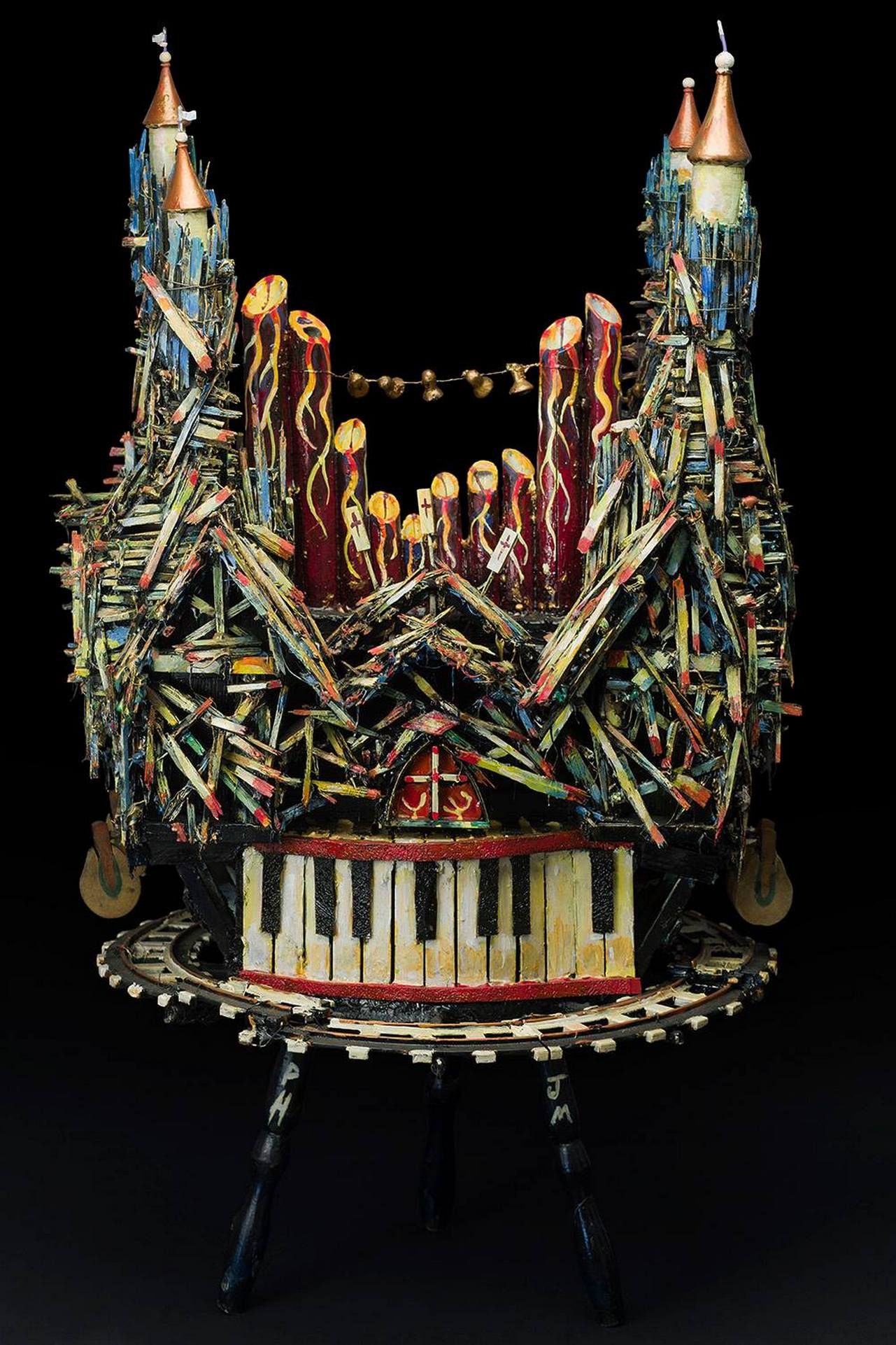
The Cathedral of St. John the Divine (2005) by Kevin Blythe Sampson. Mixed media, 34in x 18in x 19in. Image courtesy of the Artist. “Dedicated to my mentor, the Very Rev. James Parks Morton.”—Kevin Blythe Sampson
Sampson possesses an ability to sense the lineage of historical presence, both personally close and ancestrally far. Late last year, during his Artist-in-Residence in New Orleans, Kevin visited the African-American Holt Cemetery where graves rest above ground. Almost immediately overwhelmed by the spiritual power of the cemetery, Kevin described a buzzing in his head and a “sorry in his heart.” But he did not fear the place, and says “it felt like home.” At the cemetery, he spoke with a man from Georgia who was tending the graves and who reassured Kevin that those buried in the cemetery like to be visited and spoken to. Shortly after, Sampson called his mother to tell her about his experience. His mother answered that she and Sampson’s father were in that same cemetery many years before—and that to Sampson’s astonishment—his father, being in that same place, had had the same felt experience as Kevin. The father of Kevin, previously in Holt too, felt that “the spirits were surrounding him and he couldn’t breathe.” Kevin knew he had been there before. The past is so strong that Sampson knows its feeling in the present.
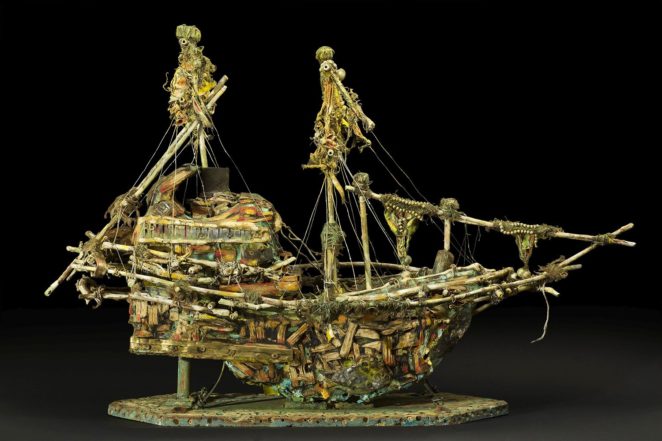
The Kron-Printzen (2014) by Kevin Blythe Sampson. Wood, Metal, String, and Found Objects, 28in x 10in x 36in. Image courtesy of the Artist.
The spirits that Sampson encounters are present in his art. The Kron-Printzen (2014) is about a Danish slave ship that sank in 1706. There were 820 slaves on board who remained buried beneath the ocean. Another work, The Madjet (2014), takes its name from a constellation. It is a ship that appears to carry the spirits of the dead, traversing the underworld—a ghost ship that moves. On the surface of the ocean, and at sunrise, constellations disappear into the depths of the ocean only to reappear once again after sunset. Perhaps those people transported on the ships themselves, crossing the waters, were the first to understand this.
Newark itself may be a ship where, today, the constellation of social relations is falling like stars beneath the water. It is as if every periphery within the dominant system risks sinking at the same time. Sampson’s work is to dig, find, and give the constellations their air once again.
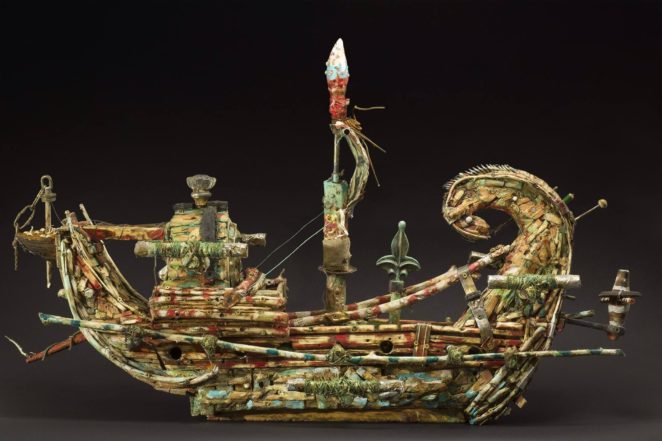
The Madjet (2014) by Kevin Blythe Sampson. Wood, Metal, String, and Found Objects, 28in x 26in x 9in. Image courtesy of the Artist.
It is a fact that Newark is avoided, yet desired. Its dynamics and relations are longed for by newcomers who might be fascinated by Newark’s legacy—but at the same time, society moves forward to the reification of relations. This withholds a cultural ambiguity and attitude towards the city. Even The New York Times’ Real Estate section has captured feelings of unpleasantness alongside driven interests from those new and outside Newark in the words of one of its major developers, stating Newark “is the largest city in the state and for too long it’s been hamstrung by people’s discomfort with its reputation.”[11] In The Civilizing Process, Norbert Elias says that “fear, distaste, guilt, associations and emotions of the most disparate kinds exaggerate the probable danger.”[12] Newark’s rawness is withheld from those who do not possess its reality.
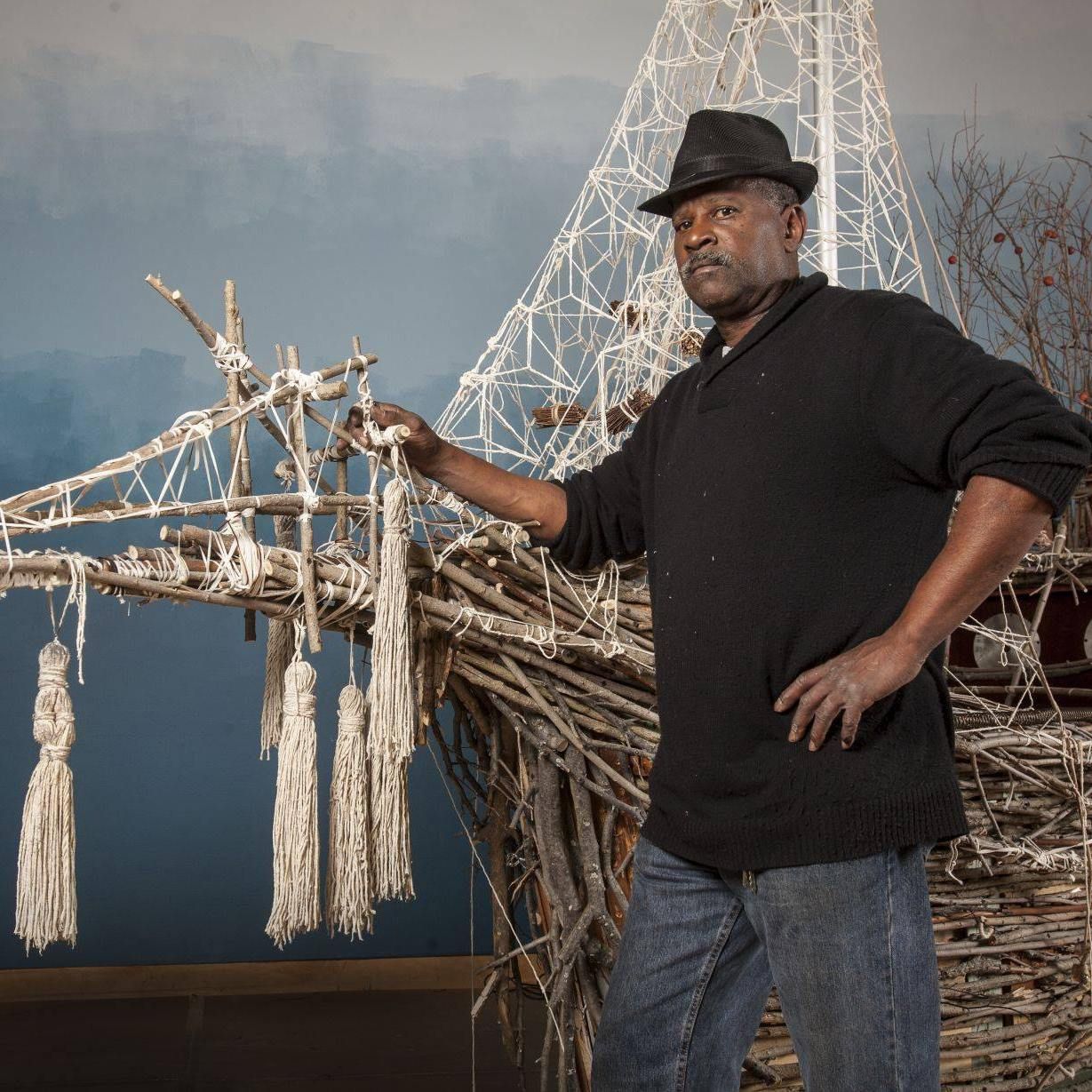
Kevin Blythe Sampson with his artwork (2011). Photograph by Jeffrey Machtig. Image courtesy of the John Michael Kohler Art Center.
On the other hand, in connection to both the decay and gentrification, Kevin explains that responding to these processes is “not a Newark artist thing but a cultural thing. It’s what African Americans and people of color historically do. It’s a way of life.” What happens if Newark loses its people and its way because of abstract revivals from above? What if its flesh and soul are no longer to be found?
SB: Kevin is a leader who is now walking in the steps of his Father. First, could you tell us more about your Father, and being a child of the Civil Rights movement?
KBS: My Father, Stephen Sampson, was one of New Jersey’s most important community activists and Civil Rights leaders for over 60 years. I am a Civil Rights baby. I grew up marching and singing on picket lines as soon as I could walk. My house was a magnet for Civil Rights planning and discussions. Many of America’s most important leaders at some point sat around my kitchen table. Everyone from Congresswoman Shirley Chisholm, who became a mentor to my Father, to William Kunstlers, Dick Gregory, Ossie Davis, and Ruby Dee. Some of my Father’s Civil Rights partners were Jewish, so I grew up learning about the Holocaust along with the African-American struggle. My Father is the man that I still most admire.
SB: Can you discuss art as a politics of reclamation in relation to your work, and how this relates to the specificity of Newark?
KBS: As a found object assemblage artist, my focus is on finding objects and utilizing the memories and magic that I believe these objects still hold upon my finding them. Thus, I am reclaiming these objects and in the process giving them a new life. This is not particularly a Newark thing—it is more of a cultural thing, as this kind of reclamation is done in cities, as well as throughout the South. In fact, it is very African-American in its origins, from Soul food, which historically used the parts that weren’t desired by the dominant culture, to the yard shows created throughout the South.
What I do is create spirit necklaces from a vanquished peoples magic.
SB: You recently returned from the Joan Mitchell Center Artist-in-Residence Program in New Orleans. How has this influenced your work?
KBS: I just spent a month at the JMC, which was one of the best experiences of my art life. Out of respect to the NOLA (New Orleans, Louisiana) community, I first wanted to get to know this community before I began collecting objects from it. This was a matter of respect. I went into this community and discovered myself. I met so many people that I immediately took too, these folks drove and walked me around NOLA and showed me many parts that a tourist would never see. NOLA was also a Master Class in Gentrification. Walking around it, I observed so many new people from New York and the North that I at times thought I was in Brooklyn. Complete with the same attitudes everyone else spoke, so it was obvious that the newcomers were just that.
I spoke to a group of young African Americans, who were complaining about gentrification. I asked them, “how are you finding it?” They told me that they go “dark”—that they go deep into their culture, put it on display, and then put it right in the faces of the newcomers so that they are reminded that they were there first.
NOLA was so in your face African-American, its people were much like family that I grew up with. The same wonderful values, family, community, and culture. I wouldn’t say that NOLA informed my work as much as it restored my soul. The JMC was a most amazing residency that allows the artist to have the quiet needed to think, explore, and grow.
SB: Can you speak about the word senzala?
KBS: I titled my studio Senzala. I live in a mostly Brazilian-Portuguese community, and as I understand it, senzala is a slave house. In fact, it’s the slaves’ house, which sits closest to the masters’. I used it to reference Newark and its close proximity to New York City, the art masters’ house.
SB: Living in Newark a few years ago, I found a reality that is counter to the dominant land use narrative. Transient, dispossessed people migrate to Newark during a time of urban decay as a strategical location for staying power. Decay actually seems to create these new opportunities for different types of permanency. Do you find this in parallel to your art?
KBS: Not really. Newark is a big city where suffering folks come to hide, and this used to be true for people of color. But the new people who are drug addicts coming to Newark are, in fact, white kids who are heroin addicts. My work is not hiding in Newark at all—it transcends its circumstance.
SB: Can you give other examples of art as a politics of reclamation, outside of your work and in Newark?
KBS: Anywhere there are poor people—or those outside of the system—there is reclamation. This is not only in visual art, but also in music. Rap is a perfect example of artists who use the dominant culture’s language and turn it on its head. Reclamation is such a people of color thing; it’s a way of getting around the system, of unifying its castoff, and thus transcending your circumstances.
SB: The most recent phase of decay differs from past phases because it is about financialization. Perhaps the gentrification is because the City of Newark now, more than anything, needs consumers? Do artists risk becoming a spectacle for drawing attention away from the core issue?
KBS: I think that decay has always been about financialization, from Detroit to Appalachia, it’s always been about business or the lack there of. About keeping the poor, poor—after using them and then moving on.
Of course Newark can use more business and jobs, which new business will bring in, but what’s the point of all of this if the people that live in the city don’t benefit from it? I am about new people, places, and things. I am also about lifting up people out of poverty.
Business uses artists as “Art Washers,” to use a phrase coined by Randall Morris. Artists are allowed in, they create culture and maintain abandoned spaces for the business elite. After the ground becomes fertile, they are kicked out and those with more means are brought in.
SB: Considering you fight for the inclusion of Newark’s indigenous artists in a place where money rules, how do you deal with this potential for contradiction?
KBS: I don’t think that it is a contradiction at all. I can’t stop the money from coming in and I am not against all gentrification. Newark needs new business and new jobs, there is nothing wrong with any of this as long as the people of Newark get a share of it. Artists are a part of the people of Newark, too.
SB: You mention that the newly emerging Newark does not intend to support the artists that are from Newark. Can you explain why this is happening?
KBS: For many years, I have been fighting for the quality of art in Newark. There was a time when, because of the great artwork that was being made in Newark, curators, artists, and the art world came to see what was going on. It was driven by good art. Now what we have is an “art scene” here in Newark. It’s more about the social aspects of the art world than actual good art making.
Newark still uses its indigenous artists when they apply for grants or create programs, but they don’t give anything back in return. Newark’s indigenous artists are the exploited flavor of the month.
People came into Newark without any real art knowledge. Then they set themselves up with help from the business community, in spaces and in a time, with not a lot of places to see art—excluding, two good examples of what art spaces should be. Most of what is going on in the art world in Newark is controlled by the business community. What Newark lacks is visionaries, what it has is good grant writers.
What will truly happen here in Newark as it loses its older artists, the keepers of the flame? It will lose its realness and its rawness and then people will ask—what happened?
I don’t have a lot of hope for Newark’s art world. I really don’t.
SB: I mentioned in the Journal of Biourbanism rural issue that at the core of the urban system, there is a connection between corruption and corrosion, and decay and decadence.[13] I think the artist is on the edge of this cut. What is your opinion?
KBS: I think that corrosion is almost a natural byproduct of the world becoming global. Industry moved because it could. Artists are always on the edge of this. It’s our place, or should be, to give a voice to the voiceless and record and interpret this decay.
SB: Of the artists we will be hearing from—Cesar Melgar, Gladys Grauer (Newark’s oldest artist), James Wilson, German Pitre, Manuel Acevedo—could you tell us a little more about them? Can you speak more of the voices that we are about to hear?
KBS: Gladys Grauer, who is now well into her 90s, is the mother of Newark artists. She has been fighting for the rights of artists since the 50s. She is “Our Lady of Newark Artists.”
The rest, James, German, Manuel, and Cesar are family to me—they are my support group. James is my adopted son. He was my daughter’s best friend in high school and needed a place to stay, so he moved in with me and my family and I adopted him. He is a long-term student of mine. I have been teaching Cesar since he was in his teens; his father and mother are close friends of mine. Like James, I have taught Cesar most of the things that I know. Cesar and James are Newark’s future. German and Manuel are my peers. I speak to them most days on the phone and constantly consult them.
Kevin Blythe Sampson’s work will be featured in the upcoming New York City–Philadelphia two-venue exhibition at Rush Arts Philly, “High John the Conqueror Ain’t Got Nothing on Me: American Hoodoo and Southern Black American-centric Spiritual Ways,” on view from January 21–March 18, 2017, curated by Danny Simmons and Shantrelle P. Lewis.
Sampson was recently in the Newark Museum group exhibition of “Modern Heroics: 75 Years of African-American Expressionism,” organized by Tricia Laughlin Bloom, PhD, Curator of American Art.
Kevin Blythe Sampson’s artwork has been represented by Cavin-Morris Gallery in Chelsea, New York City for more than 20 years,[14] and he can be found at The Most Well Connected Poor Man in America: The Art of Kevin Blythe Sampson.[15] Kevin is currently a Teaching Artist at the Paul Robeson Galleries, Newark School of Fine and Industrial Arts at Rutgers.
Footnotes:
[1] Melgar, C. (2016). Newark [All Issue Photography]. Journal of Biourbanism, IV(1&2/2015).
[2] Urban “blight” is analogous to urban decay and a term of botanic origin. The City of Newark’s 1947 Master Plan utilized the categories of “Blighted Area” for rehabilitation and “Obsolete Area” for clearance. See Central Planning Board Newark, New Jersey. (1947). The master plan for the physical development of the City of Newark, N.J. (“A Proposed Housing Program for Newark”) (p. 43, Plate No. 5). City of Newark: Office of Planning, Zoning & Sustainability. Retrieved from https://planitnewark.files.wordpress.com/2011/01/1947newark.pdf
[3] Williams, J. (2014). Unfinished agenda: Urban politics in the era of Black Power. Berkeley: North Atlantic Books.
[4] Population estimate as of July 1, 2015. United States Census Bureau. (2016). Retrieved from http://www.census.gov/quickfacts/table/PST045215/3451000
[5] The Newark Central Planning Board. (2012, September 24). Newark’s master plan: Our city our future (Vol. 1). (“11: Household Economic Insecurity” in Policy Goals: Goal 01 Economic Development) (p. 20). City of Newark: Office of Planning, Zoning & Sustainability. Retrieved from https://ndex.ci.newark.nj.us/dsweb/Get/Document-515469/econ_MstrPlan_2012_vol2.pdf
[6] As of November 2016. CareerTrends. (2016). Newark, New Jersey. Retrieved from http://unemployment-rates.careertrends.com/l/3614/Newark-NJ
[7] Bissen, S. (2014). Untouchability of the rural in the urban: Dispossession, decay and the emergence of squatting as resistance in Newark. A thesis submitted to The New School in partial fulfillment of the requirements for the degree of Master of Arts in International Affairs. New York: The Graduate Program in International Affairs.
[8] As of December 2016. RealtyTrac. (2016). Newark real estate statistics & foreclosure trends summary. Retrieved from http://www.realtytrac.com/statsandtrends/nj/essex-county/newark
[9] Bissen, S. Untouchability of the rural in the urban, op. cit.
[10] Melgar, C. (2016). Newark. Journal of Biourbanism, IV(1&2/2015), 13−15.
[11] Kaysen, R. (2016, August 19). In Newark, a new chapter unfolding. The New York Times. Retrieved from http://www.nytimes.com/2016/08/21/realestate/in-newark-a-new-chapter-unfolding.html?_r=0
[12] Elias, N. (2000 [1939]). The civilizing process: Sociogenetic and psychogenetic investigations. E. Dunning, J. Goudsblom, & S. Mennell (Eds.). (E. Jephcott, Trans.). (p. 104). Malden, MA: Blackwell.
[13] Bissen, S. (2016). Editor’s Note. Journal of Biourbanism, IV(1&2/2015), 8.
[14] Cavin-Morris Gallery. (2014, October 30). Kevin Blythe Sampson: Ironbound. Retrieved from http://www.cavinmorris.com/blog/2014/10/30/kevin-blythe-sampson-ironbound
[15] K B Sampson. (2017). The most well connected poor man in America: The art of Kevin Blythe Sampson. Retrieved from http://senzala-senzala.blogspot.it/
For further study, see: Newark—on Heterogenesis of Urban Decay